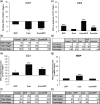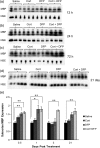Oligodendrocyte involvement in Gulf War Illness
- PMID: 31339622
- PMCID: PMC6899710
- DOI: 10.1002/glia.23668
Oligodendrocyte involvement in Gulf War Illness
Abstract
Low level sarin nerve gas and other anti-cholinesterase agents have been implicated in Gulf War illness (GWI), a chronic multi-symptom disorder characterized by cognitive, pain and fatigue symptoms that continues to afflict roughly 32% of veterans from the 1990-1991 Gulf War. How disrupting cholinergic synaptic transmission could produce chronic illness is unclear, but recent research indicates that acetylcholine also mediates communication between axons and oligodendrocytes. Here we investigated the hypothesis that oligodendrocyte development is disrupted by Gulf War agents, by experiments using the sarin-surrogate acetylcholinesterase inhibitor, diisopropyl fluorophosphate (DFP). The effects of corticosterone, which is used in some GWI animal models, were also investigated. The data show that DFP decreased both the number of mature and dividing oligodendrocytes in the rat prefrontal cortex (PFC), but differences were found between PFC and corpus callosum. The differences seen between the PFC and corpus callosum likely reflect the higher percentage of proliferating oligodendroglia in the adult PFC. In cell culture, DFP also decreased oligodendrocyte survival through a non-cholinergic mechanism. Corticosterone promoted maturation of oligodendrocytes, and when used in combination with DFP it had protective effects by increasing the pool of mature oligodendrocytes and decreasing proliferation. Cell culture studies indicate direct effects of both DFP and corticosterone on OPCs, and by comparison with in vivo results, we conclude that in addition to direct effects, systemic effects and interruption of neuron-glia interactions contribute to the detrimental effects of GW agents on oligodendrocytes. Our results demonstrate that oligodendrocytes are an important component of the pathophysiology of GWI.
Keywords: Gulf War illness; acetylcholine; activity-dependent myelination; cholinergic; corticosterone; myelin; organophosphate; plasticity; white matter.
Published 2019. This article is a U.S. Government work and is in the public domain in the USA. GLIA published by Wiley Periodicals, Inc.
Figures






References
-
- Alonso, G. (2000). Prolonged corticosterone treatment of adult rats inhibits the proliferation of oligodendrocyte progenitors present throughout white and gray matter regions of the brain. Glia, 31(3), 219–231. - PubMed
-
- Ashbrook, D. G. , Hing, B. , Michalovicz, L. T. , Kelly, K. A. , Miller, J. V. , de Vega, W. C. , … McGowan, P. O. (2018). Epigenetic impacts of stress priming of the neuroinflammatory response to sarin surrogate in mice: A model of gulf war illness. Journal of Neuroinflammation, 15(1), 86. - PMC - PubMed
-
- Bartholdi, D. , & Schwab, M. E. (1998). Oligodendroglial reaction following spinal cord injury in rat: Transient upregulation of MBP mRNA. Glia, 23(3), 278–284. - PubMed
-
- Benowitz, L. I. , & Routtenberg, A. (1997). GAP‐43: An intrinsic determinant of neuronal development and plasticity. Trends in Neurosciences, 20(2), 84–91. - PubMed
Publication types
MeSH terms
Substances
LinkOut - more resources
Full Text Sources
Miscellaneous

